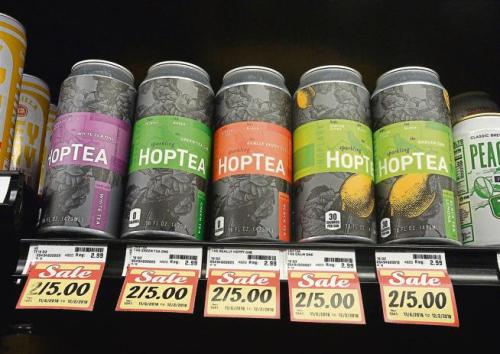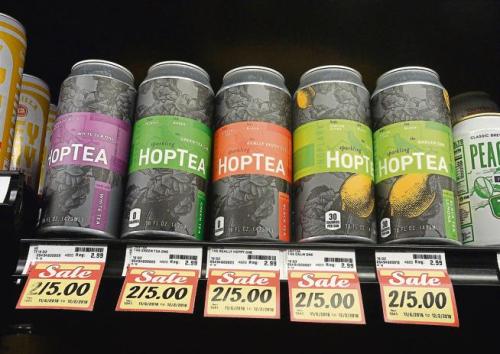Boulder County’s Hoplark HopTea and Ethan’s both have turned healthier drink ideas into successful companies
For years, a question brewed in the minds of Dean Eberhardt and Andrew Markley: How to find a drink that is as interesting as craft beer, but with no calories and alcohol? Unable to find one, the Boulder homebrewers decided to concoct one.
They began with mixing hops, tea and water. The experimentation continued for 18 months before the duo hit the perfect recipe.
“We created something that didn’t exist before,” Eberhardt said.
Soon, he and his best friend and partner Markley shared their “healthy” drink with family and friends, and, encouraged by their comments, decided to test it at Denver’s South Pearl Street Farmers Market in May. “We poured it thorough kegs and people went crazy for it,” Eberhardt said.
This prompted them to fast forward their plans to commercially launch Hoplark HopTea, the one-of-its kind zero-calorie, hop-infused sparkling iced tea .
The partners were thinking about millennials as potential customers, but didn’t know their beverage would be readily embraced by a far greater number of that demographic than they anticipated, Eberhardt said.
They made their first delivery in early June at Lolita’s Market & Deli in Boulder, and slowly expanded their retail footprint gaining shelf space in Cured, Lucky’s Market and Whole Foods Markets to name a few.
Advertisement
HopTea’s quick success can be attributed to the increasing popularity of better-for-you beverages. In the last decades or so, consumers have been inundated with a variety of drinks that tout nutrition, taste and convenience as a selling point. The line of drinks, often also called functional or hybrid, are being manufactured by both big companies and small independent entrepreneurs.

Dean Eberhardt and Andrew Markley started Hoplark HopTea in their quest for a drink that was as interesting as craft beer, but with no calories and alcohol. Their beverages now can be found at retailers across the region, including Lucky’s Market where these cans were on display. (Cliff Grassmick / Staff Photographer)
The functional drinks global market size is expected to reach about $94 billion by 2019, according to a study by San Francisco-based Grand View Research. The functional drinks U.S. market is expected to register a compound annual growth rate of 6.1 percent in terms of revenue, because of increasing popularity of such beverages, the study reports.
Priscilla Pritchard, president, Old School Insights, LLC, a Boulder-based marketing, advertising and consumer research agency, said, “Boulder is the petri dish for natural food and beverage innovation.” There is an incredible knowledge base and the availability of angel investors in Boulder, she said.
Entrepreneurs today are savvy in their understanding of consumer trends, particularly those that could appeal to millennials when they develop a product, Pritchard said. At the same time, consumers also are conscious about their purchases. “They want authenticity, want to support small companies that are doing good, and making a product that satisfies them,” she said.
Ethan Hirshberg, who successfully introduced Ethan’s apple cider vinegar shots to the retail market in 2017, and earlier this year a new range of organic medium chain triglycerides shots, was influenced by “the growing trend in health and wellness shots and a need for a convenient and better tasting delivery” of apple cider vinegar and medium chain triglycerides.
Ethan’shas “an on-trend ingredient and an on-trending format” to appeal to consumers, he said.
“We don’t tout any one specific health benefit. We’ve found an awesome variety of health benefits in our products.” The new MCT shots provide an easy way for fatty acids to be absorbed by the body, and are available in multiple flavors including matcha and coffee, Hirshberg said. He considers Ethan’s line to be ready-to-drink products. “The shot is something retailers are excited about,” he said.
His 2-ounce apple cider vinegar shots retail for $2.99 and 2-ounce medium chain triglycerides shots for $3.99.
A startup beverage company needs to position itself differently in the marketplace, develop recognition for its brand and get trials so that consumers can get a taste, Pritchard said. “Trials will get you distribution.”
The more retail outlets you can have your products in the more successful you’ll be, she said. The final piece of the puzzle to ensure success is to “check back with your consumers,” she said.
Brian Marks, coffee and local foods buyer for Lucky’s Market, which sells HopTea in Colorado stores, said he looks for locally made innovative and unique products.
“When looking for new beverages to carry in our stores, I usually start with ingredients and nutritional information and for local. I check the location of the headquarters and production facility,” he said, adding that it is easier to support local products with in-store demonstrations.
Market tests have shown that customers discovered Hoplark HopTea in stores, liked it and returned to buy more, Eberhardt said. He continue to offer samples to customers at in-store demos and to listen to them. Customers want to experience new flavors, he said. HopTea is available in five flavors, he said, adding a single can retails for $2.99.
“Beverage categories are starting to blur,” said Gary A. Hemphill, managing director of research at Beverage Marketing Corp. in New York City. The beverage landscape has rapidly segmented in recent years. People have more beverages than ever to choose from, he said.
“Most of these new products tend to be niche — targeted at a specific demographic, time of day, or consumer need. Thus they may never develop into large brands, but can still be successful within their niche,” Hemphill said.
Ethan’s success, as seen in the national distribution of its 13 products, was built on customer feedback through in-person interaction in retail stores and social media, Hirshberg said.
“That’s helped us understand what we’re doing right — glass packaging, including a research-based functional dose of the key ingredient, and what we’re doing wrong — we launched in small-mouth bottles that people were having trouble drinking from, and changed them over to “wide-mouth” bottles per consumer preference.”
Packaging of a product plays a role in the success of a beverage, “but taste is king,” said Holly McHugh, a marketing expert at Imbibe, a beverage development company in the Chicago area. She said “consumer preferences are a moving target, but there are larger trends like clean label, sustainability, sugar reduction and food as medicine that are influencing product success.”
McHugh said she thinks there is a lot of opportunity for smaller brands introducing innovative products. “If they do well, there’s a chance the brand will be acquired by a larger player like Pepsi or Coke,” she said.
Pratik Joshi: 303-684-5310, pjoshi@dailycamera.com

